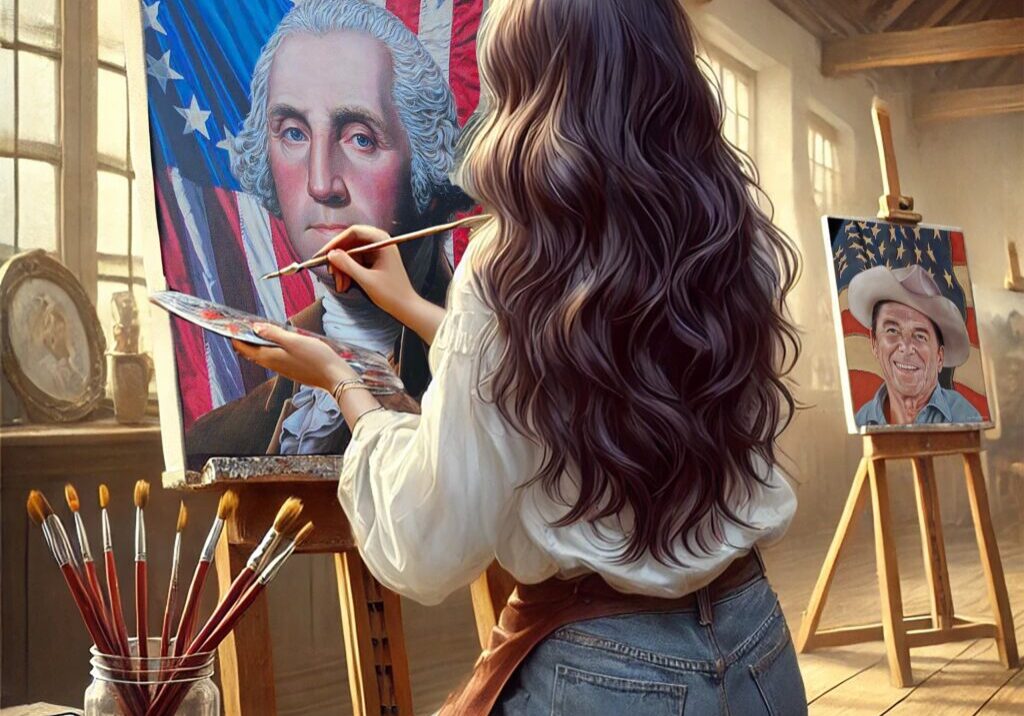
The Hand Behind the History: Rosemary Vasquez Tuthill’s Painted Storytelling
When people first encounter the 250th Anniversary Mural, they’re usually drawn in by its size. But once they begin to look closely, I hope what keeps them there is the feeling that something deeper is happening – something personal, layered, and intentionally human. I didn’t want this mural to simply display history. I wanted it to invite memory, to ask questions, and to pull people into the lived emotional world of the Revolution. That meant my job wasn’t just to paint figures and scenes. It was to listen to the past and let it speak through brush, color, and form. Storytelling, for me, doesn’t begin with the final image. It begins with small questions.
What does the weight of a letter feel like in the hand of someone risking their life by sending it? What would a street sound like when a protest flier is nailed into place? What kind of posture does a person hold when they’re torn between fear and duty? These are the questions that guide the visual tone of my work. I’m not just asking what happened. I’m asking what it felt like. When I start a mural section, I don’t begin with the obvious. I begin with the overlooked. The posture of a bystander. The way clothing folds when someone stands still for too long.
The direction of a gaze between two people who haven’t yet spoken but share a purpose. These are the emotional throughlines that build scenes with resonance. Revolutionary history is filled with enormous moments – battles, declarations, marches – but it’s also built on quiet, barely seen ones. A foot hesitating on a step. A hand pulling a curtain back to listen. A set of shoulders that carry the weight of choice. These are the visual cues I chase. In the mural, each figure has a reason to be where they are – even the ones in the background. Especially those. I don’t treat anyone as filler. Each person might be standing for hundreds of others whose names we’ve forgotten. So I try to give them presence. Not in a theatrical way, but in a way that suggests they, too, had voices, thoughts, and fears that mattered. You may not know their story, but you can feel that they have one.
My palette choices are another part of how I tell story. I use color emotionally, not just historically. Earth tones ground the viewer, but they also soften the edges of time. I often mute my blues and soften my whites to evoke candlelight, aging paper, and the kind of memory that doesn’t shine – it glows. Warm shadows suggest intimacy. Dusty reds imply urgency. These tones create a quiet tension that mirrors the emotional atmosphere of the Revolutionary period. I don’t want the mural to feel nostalgic. I want it to feel alive with the complexity of the choices people had to make. There’s a rhythm to the painting as well – visual pacing. In every section, I balance energy with stillness.
A marching group will always be mirrored by a moment of pause – a woman reading alone, a child waiting by a window, a poster falling to the ground. These silent moments give viewers a place to enter the scene with empathy. They slow the eye just enough to allow the heart to catch up. I think a lot about tempo when I paint. If everything shouts, the message is lost. But if you guide the viewer’s attention with quiet moments, the louder ones resonate more deeply. I also embed visual metaphors throughout the mural. A paper drifting upward can suggest both communication and the fragility of freedom. A bent nail in a wooden post can represent unfinished work.
A coat folded carefully on a bench may say more about absence than a portrait ever could. These choices are subtle, but they’re intentional. They’re part of the language I speak with the brush when words are too heavy or too late. People sometimes ask how I manage to stay connected to a project this large and this historical. The truth is, I feel a deep personal connection to the individuals whose stories I’m interpreting. I think about the women who never signed their names to the cause but still printed leaflets, sewed messages into flags, or taught ideas in whispered conversations. I think about the men who carried more than weapons – who carried the burden of doubt, the guilt of survival, or the weight of hope. I think about the children watching all of this unfold, absorbing meaning from glances and symbols rather than speeches. These are the emotional threads I try to paint.
This mural is a conversation between centuries. It speaks through pigment, posture, and light. It asks viewers to look more closely, not just at the figures, but at the space between them. That space – the distance between a hand and a poster, or a soldier and a scroll – is where the story really lives. And as the one holding the brush, I’m not just recording the past. I’m walking alongside it, listening for what still needs to be said.

